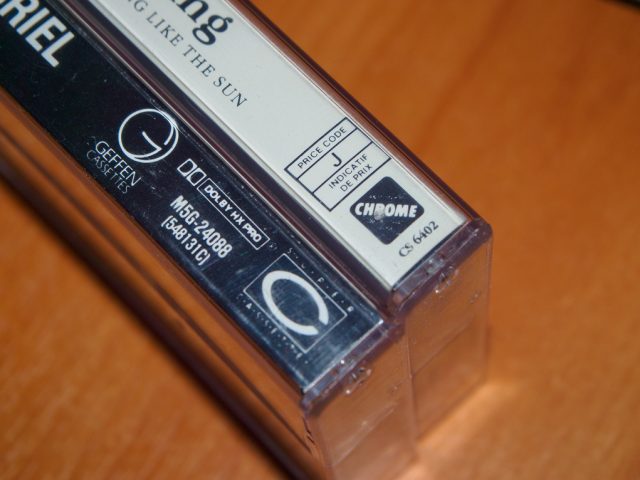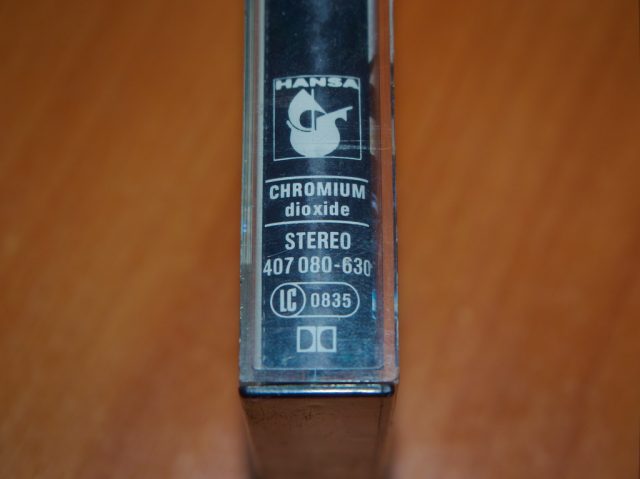What do all those cryptic pictures, words and numbers on old cassettes mean? Do they mean anything for a casual listener or they are all record-industry-related?
To answer this, let’s take this cassette for example:
What we can see here?
- The manufacturer’s logo: Hansa. Not quite interesting for a casual listener except if you love this particular label and want to buy more of their releases.
- Tape type: Chromium dioxide. Now that is very important, so we need to elaborate on that.
Chromium dioxide (otherwise known as Chrome, CrO2 or Type II) means you may (or may not) need to press the Type II (CrO2) button on your tape deck or move the switch on your portable player to the Chrome/Metal position.
Unfortunately, whether you really need to do it or not, depends on the EQ curve the tape was recorded with: 70 μs (CrO2 eq.) or 120 μs (Normal eq.). If you cannot find any special indications anywhere on the cassette itself or on the sleeve, that means with 99% probability the tape was recorded with the 120 μs (Normal eq.) EQ and you need to press Type I (Normal) switch despite it being a chrome tape!
Unfortunately that also means that the recording quality of this particular tape is somewhat lower than what a chrome tape can actually deliver when recorded with its recommended Type II EQ of 70 μs. The main reason for recording with the Normal EQ instead of CrO2 was the prevalence of the low-grade playback equipment incapable of switching between tape types among the general audience, therefore pop and rock music cassettes were in most cases recorded with the Normal EQ despite using a chrome tape. In contrast, many classical music cassettes were recorded with the true Type II EQ of 70 μs.
But let’s continue.
- Number of channels: Stereo. Not of much use, unless it says Mono and you wonder why the sound is lacking any space.
- Release serial number: 407 080-630. Needed only for cataloguing.
- Label code (LC): 0835. Needed only for cataloguing.
- The Dolby logo. That’s again very important and needs to be detailed on.
Generally, if you see the Dolby (the double D) logo together or without the Dolby System text anywhere on the sleeve or on the cassette itself that means you have to switch your cassette player to the Dolby B noise-reduction mode (if it has one). Why Dolby B and not C or S? Because only Dolby B was the de-facto standard for noise reduction during all the heydays of the cassette format and was even supported in the mid-range Walkmans (but quite rarely in boomboxes). On some decks it is just called Dolby NR, and instead of on and off the switch’s positions are called in and out, so set it to in. If you don’t do so you will get some quite harsh upper frequencies instead of a pleasantly balanced sound. There are some cassettes on the market that were recorded using more advanced Dolby C or even Dolby S noise reduction methods but those are quite rare. If you happen to have such a cassette, the C or S NR mode should be specified explicitly near the Dolby logo.
What about Dolby HX? Indeed, there’s a lot of cassettes that have the Dolby HX or HX PRO logo printed on them, but for a casual listener that means not too much: only that such a cassette has a better sound quality in the high frequency range than another recorded without Dolby HX. It does not require you to do anything with your equipment. The same is applicable to the cassettes with the XDR logo, which stands for eXpanded Dynamic Range. Just play these as they are and have fun.
Some other labels and logos you can meet:
- Super Cassette (the Big C): The trademark of WEA Music meaning nothing in particular, just the overall quality of their cassettes, in all the aspects.
- Price Code: A price classification code used to be put on French releases before the introduction of barcodes.
- A cassette with crossbones: The logo of early anti-piracy campaigns led by some major recording labels. Usually those were accompanied by words “Home taping is killing music (and it’s illegal)”, “No perjudiques a tu artista, di NO a la pirateria” (Do not harm your artist, say NO to piracy), etc. together with the threats of prosecution.
Shum Derevyev also does not endorse piracy, but only piracy for the sole sake of profit! Please DO make copies of our cassettes and give them to your friends, leave them in public places for others to pick up, sell them at garage sales or even in local shops: this way you help spreading the word about our artists and the cassette culture in whole, but please DO NOT duplicate and sell them in large quantities just to make profit! You are ruining the inimitable fun of the cassette culture. It’s that simple.
“Home sewing…” image source: Wikipedia


